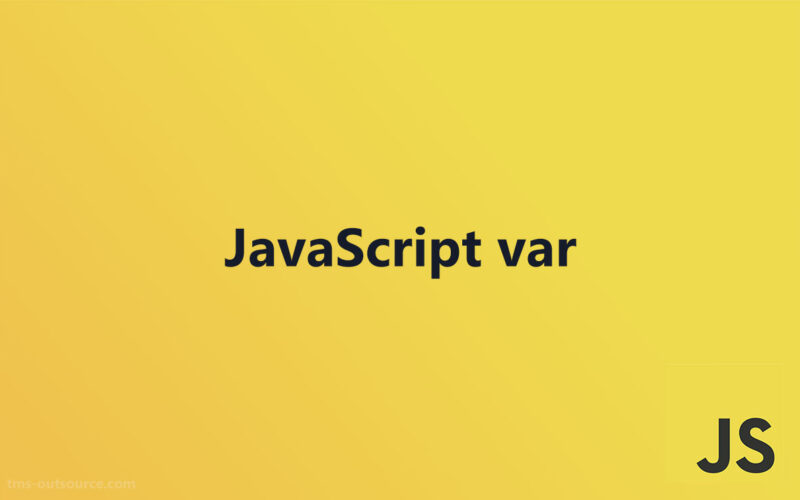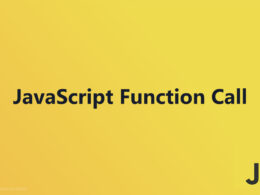The Versatility of JavaScript var in Variable Declaration

In the evolving landscape of web development, understanding JavaScript and its fundamental components is crucial. The JavaScript var keyword, once the primary option for variable declaration, plays a pivotal role in how data is handled within the script.
This article delves into its usage, scope implications, and transitions to newer keywords like let and const, offering insights and practical examples to enhance coding practices.
Declaring JavaScript Variables

The journey of JavaScript’s variable declaration syntax has seen significant evolution over the years. Initially, developers had only the “var” keyword at their disposal. Introduced in the early versions of JavaScript, var has been used to declare variables with a function scope.
However, as JavaScript applications grew more complex, the limitations of var became apparent, particularly its susceptibility to various bugs due to its scope and hoisting behavior.
This led to the introduction of two new keywords in ES6 (ECMAScript 2015): let and const. These keywords provide block scope variable declarations, which are more intuitive and safer compared to var.
The evolution from var to let and const represents a significant shift towards improving code readability and maintainability in JavaScript.
Syntax and Usage
The ‘var’ keyword (as described by MDN)
Traditionally, var has been used to declare variables that are hoisted to the top of their function scope, if declared inside a function, or to the global scope, if declared outside a function.
This can lead to situations where variables can be used before they are declared, a concept known as “hoisting.”
Introduction to ‘let’ and ‘const’ (W3Schools insights)
With the introduction of let and const, JavaScript developers gained finer control over variable scope.
let allows for the declaration of variables that are limited in scope to the block, statement, or expression where they are used. Unlike var, let does not create properties on the global object when declared globally.
const is similar to let in terms of scope, but it also prevents re-assignment to the variable.
Once a const variable is assigned, its value cannot be changed (though if it is an object or array, its properties or items can still be modified). This immutability makes const a great choice for declaring constants in an application.
Scope of Variables
The scope of a variable determines where within a program a variable is accessible. var declarations have a function scope, meaning they are available anywhere within the function they were declared in, even if it is before their actual declaration line, due to hoisting.
This often leads to confusion and bugs, particularly in long functions or functions with complex logic.
In contrast, let and const declare variables with block scope, which restricts their access to the block of code in which they are defined.
This aligns more closely with how variable scope works in many other programming languages and helps prevent errors related to variable redeclarations or unintended access outside the intended scope.
Examples and Comparisons Consider a simple loop example:
for(var i = 0; i < 10; i++) {
console.log(i); // logs numbers 0 through 9
}
console.log(i); // logs 10, because 'i' is function-scoped
for(let j = 0; j < 10; j++) {
console.log(j); // logs numbers 0 through 9
}
console.log(j); // ReferenceError: j is not defined, because 'j' is block-scoped
This example demonstrates how var can inadvertently lead to variables leaking out of their intended scope, while let keeps the variable contained within the loop block.
Variable Hoisting
Concept of Hoisting
Hoisting is a JavaScript mechanism where variable and function declarations are moved to the top of their containing scope during the compilation phase, before the code has been executed.
Essentially, it means that no matter where functions and variables are declared, they are moved to the top of their enclosing scope, whether it is global or local.
The key differences in hoisting between var, let, and const play a significant role in how they are interpreted by JavaScript. A JavaScript var declaration is hoisted and initialized to undefined at the start of the function or the global context in which it resides. However, let and const are also hoisted but not initialized, leading to a Reference Error if they are accessed before being explicitly initialized.
Practical Examples
Common pitfalls and how to avoid them
One common pitfall with hoisting is accidentally referencing a variable before it is declared. For example, using a var declared variable before its declaration line works due to hoisting, but it can lead to confusing bugs if the variable is assumed to hold a value other than undefined:
console.log(x); // undefined, not ReferenceError
var x = 5;
In contrast, trying a similar approach with let or const results in a Reference Error, which is a clearer indication of the misuse:
console.log(y); // ReferenceError: Cannot access 'y' before initialization
let y = 5;
To avoid such pitfalls, it is best practice to declare and initialize variables at the top of their scope (the top of global context or function body), which makes the code cleaner and less prone to errors due to hoisting behavior.
Tips for best practices in declarations
- Always declare variables at the beginning of their scope. This aligns with the way JavaScript interprets their declarations due to hoisting and minimizes unexpected behavior.
- Prefer
letandconstovervar. This helps to avoid unintentional global variable declarations and other oddities due to hoisting and function scoping ofvar. - Initialize variables when you declare them. This practice helps to avoid undefined errors and makes your code’s intent clearer.
By understanding and consciously applying these practices, developers can write more robust and maintainable JavaScript code.
Working with Variables
Assigning Values to Variables
Assigning values to variables is a basic but essential aspect of programming in JavaScript. Whether it’s using var, let, or const, the process involves declaring a variable and then assigning a value to it, which can then be manipulated based on the needs of your application.
Basic assignments and expressions
To assign a value to a variable, you simply use the equals sign (=), which is the assignment operator. Here’s how a basic assignment looks:
let message = "Hello, world!";
console.log(message); // Outputs: Hello, world!
This assigns the string “Hello, world!” to the variable message.
Using variables to store various data types
JavaScript supports several data types that can be stored in variables, including:
- Strings – Textual data, like
"Hello, JavaScript!". - Numbers – Both integers and floating-point numbers, such as
42or3.14159. - Booleans – Logical values, either
trueorfalse. - Objects – Complex data structures like
{name: "Alice", age: 25}. - Arrays – Lists of values, such as
[1, 2, 3, 4, 5].
Each type of data plays a unique role in development, and understanding how to store, retrieve, and manipulate these types is crucial.
Reassigning Variables
Variables declared with var or let can have their values changed, or reassigned, which is a common requirement in many programming scenarios. const, on the other hand, does not allow reassignment after its initial value is set, though objects and arrays declared with const can still have their contents modified.
Changing values of existing variables
Reassigning values is straightforward for var and let:
let count = 1;
count = 2; // Reassigning the value
console.log(count); // Outputs: 2
This flexibility is beneficial for count-controlled loops, temporary variables, and values that depend on conditional logic.
Immutable versus mutable variables (const versus let/var)
const is used for variables that should not be reassigned once they have been initialized. This is particularly useful when you want to ensure that the reference to a value remains constant throughout the lifecycle of the application, which can help prevent bugs and make the code easier to understand:
const greeting = "Hello";
greeting = "World"; // This will throw an error because `greeting` is a constant.
However, it’s important to understand that if a const variable references an object or array, the contents of the object or array can still be altered:
const person = {name: "Alice"};
person.name = "Bob"; // This is allowed
console.log(person); // Outputs: {name: "Bob"}
Utilizing const effectively can lead to cleaner, more stable code by protecting variable values from unintended changes.
Naming Conventions for Variables
Rules and Guidelines
When naming variables in JavaScript, adhering to a set of rules and guidelines ensures that your code remains clean and error-free. These are rooted in JavaScript’s interpreter constraints and are essential for the code’s functionality.
Legal versus illegal variable names (JavaScript.com guidelines)
Variable names in JavaScript can include letters, digits, underscores, and dollar signs. However, they must not start with a digit. For instance:
- Legal:
userName,$id,_user - Illegal:
1name,123
Moreover, JavaScript var names are case-sensitive. This means that Variable, variable, and VARIABLE would all be treated as distinct identifiers. It is crucial to apply consistent case usage to avoid confusion and errors.
Case sensitivity and examples of valid/invalid names
Here are a few examples illustrating case sensitivity and the correct formation of variable names:
- Valid Names
count123user_nameProfilePage
- Invalid Names
123Count(starts with a digit)user-name(hyphen is not allowed)
Using inappropriate characters or starting with a number will throw errors, making understanding case sensitivity and naming rules paramount.
Best Practices
For improving readability and maintenance of your code, following best practices in naming variables is essential.
Descriptive naming for readability and maintainability
Descriptive names make your code much easier to read and understand. A name should convey what the variable represents, making the code self-documenting:
- Good:
totalPrice,maxHeight,isActive - Bad:
tp,mh,flag
Using descriptive names not only helps during the initial development but also makes the codebase much easier to maintain and navigate, especially for new developers or when returning to older projects.
Examples of good and bad variable names
To better grasp the concept:
- Good Variable Names:
numberOfUsers(clearly describes what the variable holds)fetchUserData()(describes the action the function performs)
- Bad Variable Names:
data(too vague)get1()(ambiguous and unclear)
Choosing clear and effective names contributes significantly to the overall code quality and longevity, minimizing the chances of misunderstanding and errors in larger codebases.
Special Variable Cases
Global versus Local Variables
Understanding the impact of variable scope on accessibility is crucial for managing data correctly within your JavaScript programs. Scope dictates where variables can be accessed from within your code.
Impact of scope on variable accessibility
Global variables are those declared outside of a function and are accessible from anywhere in the script, which can be useful but risky if not used cautiously. Local variables, on the other hand, are declared within a function and can only be accessed within that function, providing a controlled environment.
Example scenarios demonstrating scope influence
Consider a program where a variable is declared both globally and locally:
var color = "blue"; // Global variable
function changeColor() {
var color = "red"; // Local variable
console.log(color); // Outputs "red"
}
changeColor();
console.log(color); // Outputs "blue"
This example showcases how local and global variables can have the same name but are treated separately. The local variable color within the changeColor function does not affect the global color variable.
Redeclaring Variables
Redeclaring variables in JavaScript can lead to different outcomes depending on the keywords used: var, let, or const.
Rules and effects of redeclaring with ‘var’, ‘let’, and ‘const’
Redeclaring a variable using var is generally allowed and the variable will retain its most recent value:
var age = 25;
var age = 30; // No error, and 'age' is now 30
Using let or const, however, will result in an error if you try to redeclare the same variable within the same scope:
let height = 180;
let height = 190; // SyntaxError: Identifier 'height' has already been declared
const further restricts reassignment, ensuring the variable cannot be reassigned or redeclared:
const weight = 160;
const weight = 165; // SyntaxError: Identifier 'weight' has already been declared
Examples from MDN documentation
From the MDN documentation, consider this scenario with let and const:
if (true) {
let name = "Anna";
let name = "Bob"; // Error
}
if (true) {
const response = "Yes";
const response = "No"; // Error
}
These examples emphasize the importance of understanding the rules regarding variable declarations and scope, as mismanaging these can lead to coding errors and unexpected bugs in your applications.
Technical Aspects of JavaScript Variables
Memory Management
Delving into how variables are managed in memory gives insight into the efficiency and performance of JavaScript applications.
How variables are stored in memory
In JavaScript, variables occupy memory space according to their data type and scope. Global variables are stored in heap memory as part of the global object, making them accessible throughout the program. Local variables are stored in the stack, which makes them quicker to access but they disappear once their execution context is out of scope.
The lifecycle of a JavaScript variable
The lifecycle of a JavaScript variable begins when it is declared. Memory for the variable is allocated at this stage. As the execution progresses, the variable may be assigned and reassigned values. Once the variable goes out of scope, the JavaScript engine’s garbage collector flags this memory as reclaimable, and it is eventually freed, thus ending the variable’s lifecycle.
JavaScript Data Types
Understanding the different data types that can be stored in variables helps developers optimize performance and resource management.
Different data types that can be stored in variables
JavaScript supports various data types and structures:
- Primitive types: such as
number,string,boolean,undefined,null,symbol, etc. - Complex types: like
objectandarray.
These types cover the broad range of needs for storing data from simple flags or counters to complex user information and collections of data.
Variable type implications on performance and behavior
The choice of data type can significantly impact how the code performs:
- Number: Performing arithmetic operations on numbers is straightforward but can use more memory compared to booleans.
- String: Strings are versatile for storing text, but operations like concatenation can lead to increased memory usage as new strings are created.
- Objects and arrays: Managing large and complex data structures like objects and arrays inherently consume more memory but provide the flexibility to handle multi-faceted data efficiently.
Each data type carries its own set of implications on memory management and execution performance, emphasizing the importance of choosing the appropriate type for the intended use to optimize application efficiency and responsiveness.
FAQ On JavaScript var
What exactly does the JavaScript var keyword do?
The keyword var in JavaScript declares a variable, optionally initializing it to a value. var variables are function-scoped or globally scoped and they are hoisted, allowing them to be accessed before their actual declaration in code.
How does var differ from let and const?
Unlike var, let provides block scope, which confines variables to the block where they are declared. const is also block-scoped but it enforces immutability, meaning once assigned, the value of a const variable cannot be changed. Both are not hoisted, which makes them safer to use in loops.
Can var variables be reassigned?
Yes, variables declared with var can be reassigned. This flexibility allows you to change the value of a var variable at any point in a program, which can be both useful and, if not carefully managed, a source of bugs.
What are the implications of hoisting in var?
Hoisting causes var declarations to be moved to the top of their enclosing scope during compilation. This often leads to confusion because it allows variables to be used before they are explicitly declared, resulting in “undefined” if accessed prematurely.
Is var still used in modern JavaScript code?
While var is still valid JavaScript, its usage has declined due to the introduction of let and const in ES6. These provide block scope and reduce bugs related to variable hoisting and scope leakage, making them preferable in most coding scenarios.
What happens if I declare a var variable twice?
Re-declaring a variable using var within the same scope overrides the original declaration without errors, though it does not reinitialize or reset the variable’s existing value unless explicitly reassigned. This can potentially lead to software bugs if not properly managed.
How does var behave in a loop?
In loop constructs, a var declared variable is hoisted to the nearest function scope. This behavior often causes unexpected issues because the same variable gets reused in each iteration of the loop, unlike block-scoped variables declared with let.
Can var be declared without initialization?
Yes, you can declare a var variable without initializing it. If a var variable is declared but not initialized, it is automatically initialized to undefined, which can sometimes lead to unintended consequences if not checked.
What is the scope of a var declared inside a function?
A var declared inside a function is limited to the function scope. It exists anywhere within the function, accessible from any part of that function, regardless of block structures like if statements or loops, unless nested within another function.
How do closures affect var variables?
In closures, var variables behave according to their function-scope nature. They are accessible within the closure and remember their environment, thus they can hold onto their values between function calls if they’re part of a function that is returned or passed around, leading to powerful but complex patterns in JavaScript.
Conclusion
Through our journey exploring the JavaScript var keyword, we’ve delved into its core functionalities, how it differs from let and const, and its nuances in scope management and variable hoisting.
As web development evolves, the shift towards more reliable and less error-prone alternatives like let and const has become evident.
However, understanding var is crucial for those reading legacy codes or aiming to solidify foundational JavaScript knowledge. Remember, each piece of knowledge enhances your fluency in the language of the web.
If you liked this article about JavaScript var, you should check out this article about JavaScript Comments.
There are also similar articles discussing JavaScript Data Types, JavaScript Variables, global vs local variables, and JavaScript Let.
And let’s not forget about articles on JavaScript Const, JavaScript Operators, JavaScript Arithmetic Operators, and JavaScript Assignment Operators.
- Share Creatively With Apps Like Vimeo - June 27, 2024
- Converting Arrays with JavaScript Array toString() Method - June 27, 2024
- 4 Best Free AI Coding Tools for Developers - June 27, 2024








